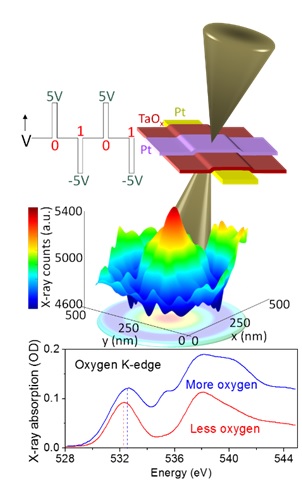Memristor technology, or resistive random access memory (RRAM), is a frontrunner for next generation computer memory, owing to the promise of long endurance, low power, nanoscale device size and fast operation.1 Memristor devices are typically made of a transition metal oxide sandwiched between two metallic electrodes, and reversibly switch resistance between high and low states with an alternating applied voltage bias of positive and negative polarity. Many models and experimental studies of resistive switching suggest local conductive channel formation by oxygen-ion-migration as the mechanism of operation.2 However, there has been no direct observation of atomic changes in a local channel during resistance switching, particularly because of the difficulty in detecting an incredibly small and nanoscale material change. Additionally, there is controversy on the role thermally-driven oxygen migration (thermophoresis or the Soret effect) plays in the resistance switching.3,4 Direct observations of the local chemical changes in memristor devices during operation would help address these questions and aid in constructing physical and compact electrical models to improve circuit design and simulation, contributing to the widespread deployment of this technology.

Figure 1. Depiction of focused x-rays used to study a crossbar tantalum oxide memristor device in-operando as it was switched between information states of 0’s and 1’s using voltage pulses. The resultant radial oxygen migration profile mapped using O K-edge x-rays, along with the spectral differences between the oxygen-rich and oxygen-deficient regions.
To tackle this lack of direct experimental observation head on, a collaboration between Hewlett Packard Labs, Stanford University, SSRL, and LBNL, Kumar et al., developed an in-operando, adaptive, time-multiplexed x-ray spectro-microscopy system to sensitively detect very small and local signal changes in x-ray absorption.5 This approach combines synchronization of resistance switching and detector signal acquisition of a scanning transmission x-ray microscope (STXM), real-time adaptation of the electrical stimulus to the device based on feedback from changes in the device’s resistance state to ensure STXM measurement of the same device state, and time-multiplexing to average the x-ray absorption signal over several resistance switching cycles, eliminating stochastic effects to ultimately produce an incredibly sensitive detection of nanoscale x-ray absorption changes correlated with the device resistance change.
By tuning x-rays to the oxygen K edge, tantalum oxide memristor crossbar devices were measured with this approach to directly observe local movement of oxygen atoms during electrical operation. As the tantalum oxide memristor devices were switched between high and low resistance states, sub-micrometer sized ring-like features with an increased concentration of oxygen atoms enclosed an oxygen deficient region that had a higher conductivity. This physical observation indicated radial oxygen migration starting from the center of a current-conduction path. Tantalum L-edge spectromicroscopy on the same device revealed negligible movement of tantalum atoms. A simple model of thermophoresis and Fick diffusion (concentration-gradient-driven movement) reproduced the formation of the oxygen-rich ring-like features.
Upon further subjecting the device to millions of voltage pulses, the ring-like features broke up to form several clusters of oxygen-rich and oxygen-deficient regions. This was accompanied by the device getting irreversibly stuck in its low resistance state, indicating that these oxygen clusters shorted the two electrodes and caused failure of the device.
The technique described here is scientifically a powerful one capable of observing atomic motion during small repeated material changes. By applying this technique to operating tantalum oxide memristor devices, the authors have shown the first direct observation of the lateral motion of oxygen and formation of an oxygen-poor region around the conducting channel in tantalum oxide memristor devices – these results highlight the important role of thermophoresis in oxygen migration, a physical driving force unobserved previously in resistive metal-oxide switching and critical to now include in physical models.
- Y. Yang, P. Sheridan, and W. Lu, Appl. Phys. Lett. 100, 203112 (2012).
- K. M. Kim, T. H. Park, and C. S. Hwang, Sci. Rep. 5 (2015).
- S. Kim, S.-J. Kim, K. M. Kim, S. R. Lee, M. Chang, E. Cho, Y.-B. Kim, C. J. Kim, U. I. Chung, and I.-K. Yoo, Sci. Rep. 3 (2013).
- S. Kim, S. Choi, and W. Lu, ACS Nano 8, 2369 (2014).
- S. Kumar, C. E. Graves, J. P. Strachan, A. L. D. Kilcoyne, T. Tyliszczak, Y. Nishi, and R. S. Williams, J. Appl. Phys. 118, 034502 (2015).
S. Kumar, C. E. Graves, J. P. Strachan, E. M. Grafals, A. L. D. Kilcoyne, T. Tyliszczak, J. Nelson Weker, Y. Nishi and R. S. Williams, "Direct Observation of Localized Radial Oxygen Migration in Functioning Tantalum Oxide Memristors", Adv. Mater. 28, 2772 (2016), DOI: 10.1002/adma.201505435.




